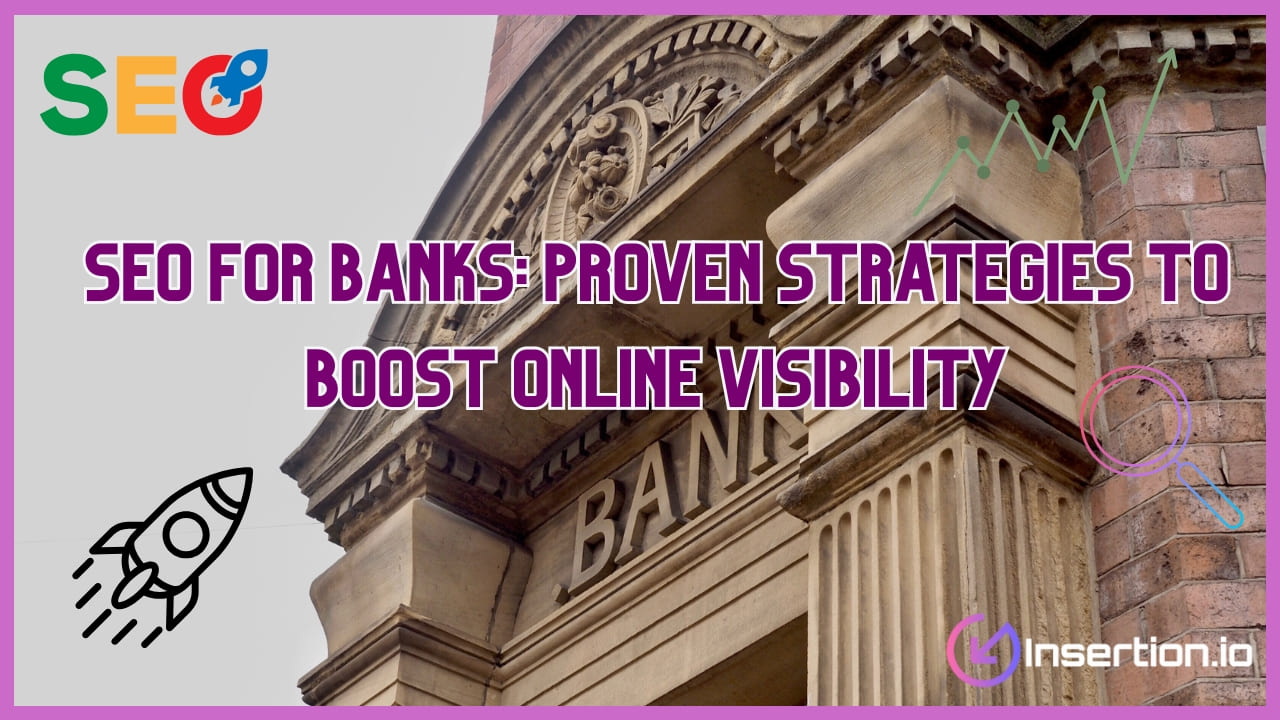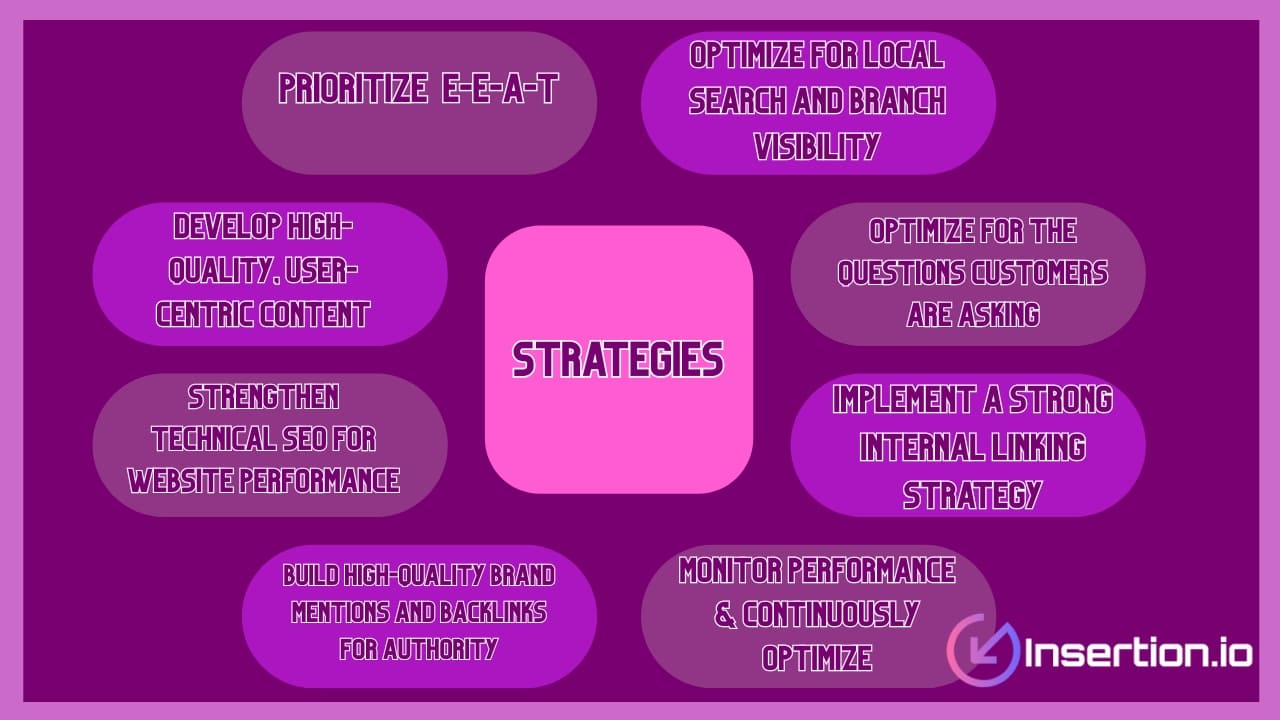
In the competitive world of digital banking, SEO for banks is crucial for standing out in search engine results. Despite offering essential financial services, many institutions remain invisible in search engine results. 80% of consumers visit at least one bank’s website before opening a new checking account, highlighting the importance of online visibility.
To address this, banks must implement effective SEO strategies tailored to the financial sector. This article explores proven SEO techniques that can enhance a bank’s online presence, attract potential customers, and foster trust. From optimizing for local searches to strengthening technical SEO, we provide a comprehensive guide to boosting your bank’s visibility in search engine results.
The Growing Importance of SEO for Banks
SEO has become increasingly crucial for banks aiming to enhance their online presence and attract potential customers. A well-executed SEO strategy can significantly improve a bank’s visibility in search engine results, particularly for local banks competing for online banking customers. By optimizing their websites and utilizing local SEO services, banks can enhance the user experience, increase organic traffic, and improve their search engine rankings.
Moreover, incorporating effective SEO practices, including technical SEO and off-page SEO, ensures that banks’ websites meet the evolving demands of search engines. Consequently, banks that invest in SEO are better positioned to reach new customers and stay ahead of their competitors in the financial services industry.
What Are The Benefits of SEO for Banks?
- Improved Online Visibility: SEO helps banks appear at the top of search results, increasing their online presence.
- Attracts Potential Customers: A well-executed SEO strategy attracts customers actively searching for banking services.
- Local SEO Advantage: Optimizing for local SEO enables banks to target customers within their service area, thereby increasing foot traffic.
- Better User Experience: SEO enhances website structure, loading speed, and mobile responsiveness, improving customer satisfaction.
- Increased Organic Traffic: With effective SEO, banks can drive high-quality organic traffic to their websites, eliminating the need for paid ads.
- Builds Trust: A strong SEO presence fosters credibility and trust, which are essential in the banking industry.
- Cost-Effective Strategy: Unlike paid ads, SEO is a long-term, sustainable investment to generate consistent results.
Top SEO Strategies for Bank Marketers

1. Prioritize E-E-A-T:
E-E-A-T (Expertise, Authoritativeness, and Trustworthiness) is crucial for bank SEO. Search engines reward websites that demonstrate these qualities. Banks must ensure their content reflects financial expertise, accuracy, and trust. Google values authoritative sources, especially for financial institutions. Providing high-quality, well-researched content establishes credibility, reassuring customers and boosting rankings. A bank’s website should also include clear contact information and industry certifications, reinforcing trust. Consistently publishing authoritative content can enhance online visibility and improve a bank’s search engine ranking, enabling customers to find credible financial information quickly and easily.
2. Optimize for Local Search and Branch Visibility:
Local SEO is essential for banks to attract nearby customers. Optimizing for Google Business Profile ensures the bank appears in local search results and on Google Maps. Include accurate location data, working hours, and service offerings for each branch. This helps banks show up when potential customers search for “find a bank near me.” It also enhances the bank’s visibility for local banking services, such as loans, mortgages, and savings accounts. Furthermore, local SEO strategies, such as creating local content and acquiring local backlinks, can significantly improve the bank’s ranking in regional search results.
3. Develop High-Quality, User-Centric Content:
Content is a key part of SEO for banks. Creating engaging, informative content that answers customers’ questions is vital. Whether it’s about financial products, services, or digital banking options, quality content drives traffic. Focus on creating content that addresses customers’ needs, such as blog posts about banking products, investment options, or personal banking tips. This approach not only improves ranking but also enhances user experience. Providing valuable content builds trust with customers, turning them into repeat visitors, and helps the bank establish authority in the financial services industry.
4. Optimize for the Questions Customers Are Asking:
Banks should focus on answering the questions customers are most likely to ask. Using keyword research tools, identify the most common queries about banking services and financial products. Tailor content to these questions, such as “how to open a bank account” or “best savings accounts for high interest.” By integrating these questions and their answers into the website’s content, banks can rank for long-tail keywords, improve organic traffic, and provide valuable information that directly addresses customer concerns. Answering these questions also enhances user experience and encourages users to return.
5. Strengthen Technical SEO for Website Performance:
Technical SEO ensures the bank’s website functions smoothly and loads quickly, which in turn improves its search rankings. Implementing measures such as improving site speed, ensuring mobile optimization, and utilizing secure HTTPS protocols can enhance SEO performance. Additionally, optimizing images, fixing broken links, and enhancing site structure for easy navigation all improve the user experience. Search engines like Google prioritize websites that are well-optimized in their rankings. Regularly conducting an SEO audit can help banks identify and fix any technical issues that may hinder performance, ensuring a smoother browsing experience for customers.
6. Implement a Strong Internal Linking Strategy:
Internal linking is a powerful tool for enhancing SEO in the banking industry. By strategically linking relevant pages on their website, banks can guide visitors to important content, such as financial products, loan applications, or savings calculators. A solid internal linking strategy not only improves user navigation but also helps search engines crawl the site more effectively. Ensure that links direct customers to high-value pages that they may find useful. This practice keeps visitors engaged longer, boosts page authority, and improves rankings, making it easier for search engines to index key content.
7. Build High-Quality Brand Mentions and Backlinks for Authority:
Backlinks and brand mentions are key components in building authority and trust for a bank’s website. Establishing relationships with reputable financial websites, industry blogs, and media outlets can lead to valuable backlinks. These backlinks signal to search engines that the bank’s website is trustworthy and authoritative. Focus on earning links from respected financial institutions, influencers, and relevant industry websites. Consistently acquiring high-quality backlinks enhances SEO, strengthens the bank’s domain authority, and improves search engine rankings, ultimately driving more organic traffic to the bank’s website.
8. Monitor Performance & Continuously Optimize:
SEO is an ongoing process. Continuously monitor the bank’s SEO performance using tools such as Google Analytics and Search Console. Track key metrics, including organic traffic, keyword rankings, and bounce rate, to measure the effectiveness of your strategies. Regularly analyzing performance enables banks to identify areas for improvement, refine their SEO strategies, and stay ahead of competitors. Additionally, customer behavior changes over time, so banks must adapt their SEO tactics to meet evolving needs and ensure long-term online visibility and customer acquisition.
Conclusion
SEO for banks is a crucial strategy for enhancing online visibility, boosting organic traffic, and attracting new customers. By focusing on key elements such as local SEO, E-E-A-T principles, and technical optimization, banks can enhance their online presence and establish credibility with customers. Regular updates and SEO efforts are crucial for staying ahead of the competition in the dynamic banking industry. With an effective SEO strategy in place or by hiring a SEO analyst, banks can ensure long-term success and continued growth in search engine rankings.
FAQs
What is SEO, and why should banks use it?
SEO (Search Engine Optimization) helps banks improve their website’s visibility in search engine results, attracting more potential customers.
How can SEO impact a bank’s online presence?
By optimizing their website and content, banks can improve their search engine ranking, enhance online visibility, and attract more traffic.
What are the key elements of a successful SEO strategy for banks?
Successful SEO strategies for banks encompass local SEO, keyword optimization, high-quality content, technical SEO, and establishing backlinks.
How does SEO help banks attract local customers?
Local SEO helps banks rank higher in location-based searches, such as “banks near me,” driving more local customers to both online and physical branches.
What is the role of keywords in SEO for banks?
Keywords are crucial for SEO, as they help banks target search terms that potential customers use to find banking products and services.


Leave a Comment